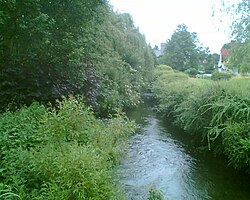| Wye | |
|---|---|
 River Wye near Wooburn Industrial Estate | |
 | |
| Location | |
| Country | England |
| Counties | Buckinghamshire |
| Towns | High Wycombe, Bourne End |
| Physical characteristics | |
| Source | |
| • location | West Wycombe, Chiltern Hills |
| • coordinates | 51°38′52″N 0°48′45″W / 51.64778°N 0.81250°W |
| • elevation | 94m |
| Mouth | River Thames |
• location | Bourne End |
• coordinates | 51°34′13″N 0°42′40″W / 51.57028°N 0.71111°W |
• elevation | 26m |
| Length | 17 km (11 mi) |
| Discharge | |
| • location | Hedsor |
| • average | 1.00 m3/s (35 cu ft/s) |
| • minimum | 0.25 m3/s (8.8 cu ft/s)25 December 1973 |
| • maximum | 4.40 m3/s (155 cu ft/s)25 September 1981 |
| Discharge | |
| • location | High Wycombe |
| • average | 0.31 m3/s (11 cu ft/s) |
The River Wye is a river in Buckinghamshire, England. It takes its name from the town of High Wycombe through which it flows, rather than the town being named after the river, as is more commonly the case.[1]
Around 10.5 miles (16.9 km) in length,[2] the Wye rises close to West Wycombe village in the Chiltern Hills and flows through High Wycombe, where it is fed from other tributataries such as Hughenden Stream,[3] before emptying into the River Thames at Bourne End, on the reach above Cookham Lock. In particularly wet years, the source can temporarily change and effectively extend the river by another mile, due to a chalk spring rising above the ground in a field further up the same valley. The River Wye now runs in underground culverts through the centre of High Wycombe.[4] Pann Mill watermill, at the eastern end of Wycombe, is the last remaining watermill on the river.[5]
